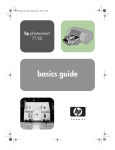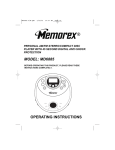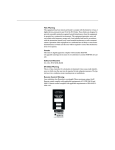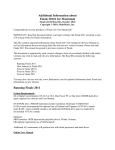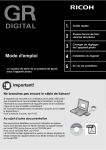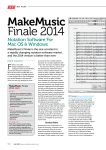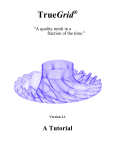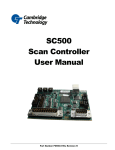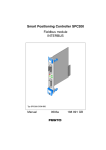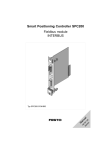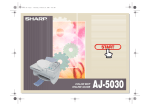Download Black Box AC400A User's Manual
Transcript
SEPTEMBER 1993 AC400A AC401A Real Color 16 LCD Projection Panel Monochrome 16 LCD Projection Panel CUSTOMER SUPPORT INFORMATION Order toll-free in the U.S. 24 hours, 7 A.M. Monday to midnight Friday: 877-877-BBOX FREE technical support, 24 hours a day, 7 days a week: Call 724-746-5500 or fax 724-746-0746 Mail order: Black Box Corporation, 1000 Park Drive, Lawrence, PA 15055-1018 Web site: www.blackbox.com • E-mail: [email protected] REAL COLOR AND MONOCHROME 16 LCD PROJECTION PANELS FEDERAL COMMUNICATIONS COMMISSION RADIO FREQUENCY INTERFERENCE STATEMENT This equipment generates, uses, and can radiate radio frequency energy and if not installed and used properly, that is, in strict accordance with the manufacturer’s instructions, may cause interference to radio communication. It has been tested and found to comply with the limits for a Class A computing device in accordance with the specifications in Subpart J of Part 15 of FCC rules, which are designed to provide reasonable protection against such interference when the equipment is operated in a commercial environment. Operation of this equipment in a residential area is likely to cause interference, in which case the user at his own expense will be required to take whatever measures may be necessary to correct the interference. Changes or modifications not expressly approved by the party responsible for compliance could void the user’s authority to operate the equipment. This digital apparatus does not exceed the Class A limits for Radio noise emission from digital apparatus set out in the Radio Interference Regulation of Industry Canada. Le présent appareil numérique n’émet pas de bruits radioélectriques dépassant les limites applicables aux appareils numériques de la classe A/ prescrites dans le Règlement sur le brouillage radioélectrique édicté par Industrie Canada. 1 REAL COLOR AND MONOCHROME 16 LCD PROJECTION PANELS TRADEMARKS UL® is a registered trademark of Underwriters Laboratories Incorporated. Macintosh® and Apple® are registered trademarks of Apple Computer, Inc. IBM® and PS/2® are registered trademarks of IBM Corporation. MS-DOS® is a registered trademark of Microsoft Corporation. Compaq® is a registered trademark of Compaq Computer Corporation. Dell® is a registered trademark of Dell Corporation. Epson® is a registered trademark of Seiko Epson C orporation. Sharp® is a registered trademark of Sharp Corporation. Toshiba® is a registered trademark of Toshiba Corporation. Zenith® is a registered trademark of Zenith Electronics Corporation. Any other trademarks mentioned in this manual are acknowledged to be the property of the trademark owners. 2 REAL COLOR AND MONOCHROME 16 LCD PROJECTION PANELS Contents Chapter Page 1. Specifications.................................................................................................. 4 2. Introduction ................................................................................................... 2.1 Description ............................................................................................ 2.2 Shipping Container Contents .............................................................. 2.3 General Guidelines ............................................................................... 5 5 6 7 3. Installation...................................................................................................... 8 3.1 Setup Instructions ................................................................................. 8 3.2 Connecting the Projection Panel to a Desktop Computer ................12 3.3 Connecting the Projection Panel to an IBM PC Compatible Laptop Computer ............................................................13 3.4 Connecting the Projection Panel to a Macintosh Series Computer ...................................................................................14 4. Operation .......................................................................................................15 4.1 Adjusting the Projection Panel ............................................................15 4.2 Non-Shift Control Button Functions ...................................................17 4.3 Shift-Activated Control Button Functions ...........................................19 4.4 Using the Control Buttons to Make Adjustments...............................22 4.5 User Menu.............................................................................................23 4.6 Moving Through the User Menu.........................................................24 4.7 Adjusting a Menu Option ....................................................................24 5. Maintenance and Troubleshooting ..............................................................28 5.1 Cleaning the Display Surface ...............................................................28 5.2 Cleaning the Projection Panel Filter ...................................................28 5.3 Troubleshooting Guide ........................................................................29 Appendix A: Working With Colors (AC400A only).........................................32 Appendix B: Interface Requirements ...............................................................33 B.1 Power Connector Polarity ....................................................................34 B.2 Screen Area...........................................................................................34 Appendix C: Special Guidelines for IBM and Compatibles ............................36 C.1 IBM Computers with Two Display Cards ............................................36 C.2 Instructions for Activating Portables and Laptops .............................37 3 REAL COLOR AND MONOCHROME 16 LCD PROJECTION PANELS 1. Specifications Resolution — 640 x 480 Power — UL® approved 12 VDC, 1.5A power supply Size — 15.3"H x 13.1"W x 2.6"D (38.9 x 33.3 x 6.6 cm) Weight — 5.9 lb. (2.7 kg) 4 CHAPTER 2: Introduction 2. Introduction 2.1 Description For remarkably impressive presentations, use the Real Color or Monochrome 16 LCD Projection Panel. The Panel, which projects 16 real colors or 16 shades of grey, delivers the computer compatibility and ease of use you never thought possible in an LCD projection panel. Fig. 2-1 illustrates the Panel coupled with an overhead projector. Fig. 2-1. The Projection Panel on an Overhead Projector. 5 REAL COLOR AND MONOCHROME 16 LCD PROJECTION PANELS The Projection Panel is easy to use. Simply connect the Panel to a computer graphics card and place the unit onto an ordinary overhead projector. The data and graphics normally displayed on the computer monitor will be projected in images that you can easily see in typical room lighting. The Projection Panel has a temperature-regulating fan, which works with the heat-producing overhead projector, to hold the liquid crystal display (LCD) to the optimum temperature. You can use the Projection Panel on a wide range of overhead projectors rated up to 650 watts. The Projection Panel, with a 640x480 pixel display, is compatible with the Macintosh® series and Macintosh II series; with Apple® IIGS RGB; with IBM® PC and compatibles in CGA, EGA, and VGA modes, and with the IBM PS/2® with VGA or CGA. 2.2 Shipping Container Contents The components shown in Fig. 2-2 are included with the Projection Panel. 1. Projection Panel 2. This User Manual 3. 12-volt power supply 4, 6. 15-pin Mac II, LC, Apple IIgs 5. 15-pin VGA If any pieces are missing when you first open the box, contact Black Box immediately. 1 4 5 6 2 3 Fig. 2-2. The Projection Panel and Included Components. 6 CHAPTER 2: Introduction 2.3 General Guidelines Follow these guidelines when you use the Projection Panel. • Be sure the Projection Panel is on whenever the overhead projector is turned on. CAUTION If the Projection Panel is not on when it is on top of an operating overhead projector, the Panel could sustain damage. • Do not use the Projection Panel for extended periods of time on an overhead projector known for discoloring or melting standard transparencies. • When you use the Panel with a high-wattage projector or if you notice extreme discoloration of the Panel, periodically remove the Panel from the overhead projector to allow it to cool. • Handle the Projection Panel as you would anything made of glass. Be especially careful not to drop it. • You can easily clean the Projection Panel with standard non-abrasive glass cleaner. Apply the cleaner to the cleaning cloth and then wipe the glass surface lightly. Do not use excessive amounts of liquid or pressure on the top or bottom optical panels. • Avoid scratching the Projection Panel surface with sharp metal objects. The top surface is made of glass or a scratch-resistant hardened polymer. If you need to clean the surface, use normal glass-cleaner solution. Do not use abrasive cleaners, solvents, or other harsh chemicals. • Avoid leaving the Projection Panel in direct sunlight or extreme cold for extended periods of time. • The bottom of the Panel can become very hot to the touch after use. Be careful to let the Panel cool before lifting it. • Do not block the Projection Panel fan or free air movement under and around the Panel. Air flows from back to front. • Turn the overhead projector off and unplug the Projection Panel when not in use. 7 REAL COLOR AND MONOCHROME 16 LCD PROJECTION PANEL 3. Installation 3.1 Setup Instructions This chapter explains the connections you must make between the three pieces of equipment you will be using—the Projection Panel, your computer, and monitor. Be sure to follow the instructions for your type of computer. Fig. 3-1. Projection Panel and Overhead Projector, Showing Cable Connections. 8 CHAPTER 3: Installation 3.1.1 CABLES Three cables are supplied with the Projection Panel: 1. A Macintosh II/Macintosh LC/Apple IIGS loop-through cable 2. A VGA/MCGA loop-through cable 3. A loop-through cable for EGA, CGA, or Macintosh video 15-pin MacII The cables that come with your Projection Panel are used to connect the computer’s video port to the Projection Panel and the monitor. Each of the three cables has a 26-pin connector for the Projection Panel, a connector matching the video card and a connector for the monitor. The Projection Panel receives the computer’s signals, amplifies the signals, and sends them out to the monitor. 15-pin VGA 9-pin VGA Fig. 3-2. Cables. 9 REAL COLOR AND MONOCHROME 16 LCD PROJECTION PANEL 3.1.2 CONNECTING THE PROJECTION PANEL TO YOUR COMPUTER You are going to make eithertwo or three connections. You will connect the computer’s graphics card to the Projection Panel, the Projection Panel to the wall outlet with the power supply, and, optionally, the Projection Panel to the computer’s monitor. The steps you need to follow are given in Section 3.1.3. Illustrations on the pages following the steps show the cable connections for your configuration. 3.1.3 SETTING UP THE PROJECTION PANEL FOR PROJECTION To set up the Projection Panel for projection, follow these steps: 1. Set up your overhead projector and plug it into the wall outlet. Turn it on to be sure it is working properly and position it so it projects onto the screen. 2. Place the Projection Panel on the overhead projector so the connectors and controls are on the right side of the projector as you face the front of the projector. 3. Connect power to the Projection Panel, but do not connect a video signal yet. This will bring up a test pattern. Move the Projection Panel on the projector until the lines are solid rather than rainbows. Adjust the tint for the best color saturation or the contrast for the best greyscale. 10 10 CHAPTER 3: Installation Computer Cable IBM or compatible with VGA Graphics Card or IBM PS/2 with built-in VGA or MCGA Graphics 15-pin IBM or Compatible with EGA or CGA Graphics Card or Classic Style Macintosh 9-pin Macintosh II Series or Macintsoh LC, Apple IIGS 15-pin Looks like Fig. 3-3. Selecting the Proper “Y” Cable for Your Computer. Refer to Appendix A for additional important information on how to properly place a Projection Panel on an overhead projector. 4. Follow the instructions in this table to select the proper “Y” cable for your computer:5. Connect the 26-pin end (marked LCD) of the “Y” cable to the Projection Panel. NOTE Skip step 6 if you are connecting to a classic-style Macintosh. 11 6. Unplug the computer monitor cable from the graphics card. Plug the monitor to the short end (marked Monitor) of the Projection Panel cable to the computer monitor. 7. Plug the long end of the Projection Panel cable (marked for the appropriate computer) to the computer’s video port. 8. Tighten the thumb screws on the cable connectors to ensure proper grounding. 11 REAL COLOR AND MONOCHROME 16 LCD PROJECTION PANEL 3.2 Connecting the Projection Panel to a Desktop Computer Figure 3-4 shows how to connect the Projection Panel to typical desktop computers, which include CGA, EGA, VGA, Macintosh II, and Macintosh LC setups. All cables are labeled (for example, LCD, Monitor, VGA, etc.) to indicate where they connect. Fig. 3-4. Desktop Computer with a Y-Cable. 12 CHAPTER 3: Installation 3.3 Connecting the Projection Panel to an IBM PC Compatible Laptop Computer Figure 3-5 shows a typical laptop installation. Fig. 3-5. Typical Laptop Installation. When the external port is activated, many laptop computers automatically turn off their internal display. For more information, see Appendix C or your computer manual for typical laptop commands. The short end of the loop-through cable is not connected in this installation. CAUTION The Projection Panel is not compatible with the Macintosh laptop. Do not attempt to connect the Projection Panel to a Macintosh laptop. Serious damage to the computer or Projection Panel could result. 13 REAL COLOR AND MONOCHROME 16 LCD PROJECTION PANEL 3.4 Connecting the Projection Panel to a Macintosh Series Computer Figure 3-6 shows how to connect the Projection Panel to a Macintosh series computer. Fig. 3-6. Macintosh Series Computer. Because classic-style Macintosh computers do not have a video connector, you must install an internal adapter. The Macintosh 128, 512, and Plus require an A10 adapter. The SE and SE/30 require an A20. The Macintosh Classic requires an A21. Call your dealer for more information. Note that the short end of the loop-through cable is not connected in this installation. 14 NOTE Because the SE and Plus models of the Macintosh computer only display in monochrome at a resolution of 512x342 pixels, a Real Color 16 LCD Projection Panel connected to one of these models will only project monochrome and will not fill the entire Projection Panel screen. CHAPTER 4: Operation 4. Operation 4.1 Adjusting the Projection Panel At this point, bring up the software you want to project. You should be projecting an image on the screen. This section will show you how to adjust the Projection Panel to get clear, crisp images. You can adjust the Projection Panel using the 10-function keypad. Some of the buttons are autorepeat buttons; that is, pressing and holding these buttons causes them to constantly send instructions. Other buttons toggle through a fixed number of settings and require you to press the button each time to trigger the next setting. 4.1.1 CONTROL BUTTON FUNCTIONS There are ten operating control buttons on the Projection Panel. A SHIFT button, located in the lower left corner, allows several of these buttons to have a dual function (non-shift functions are printed in gray, shift functions are in blue). Six of the buttons are combined as dual-action switches. 15 REAL COLOR AND MONOCHROME 16 LCD PROJECTION PANELS level tint position reset clear palette reverse shift menu position syncsync+ Fig. 4-1. Projection Panel Keypad. Table 4-1. Non-Shift and Shift Keys. 16 NON-SHIFT KEYS SHIFT KEYS Tint (up/down) Contrast (up/down) Sync+ Position (up/down) Position (left/right) Clear Reverse Level (up/down) SyncMenu (toggle) Reset Palette CHAPTER 4: Operation 4.2 Non-Shift Control Buttons To activate one of the non-shift buttons (printed in grey) on the operating control panel, just press the button. level contrast 4.2.1 TINT (TRUE COLOR) Press the Tint key to adjust the color. The Tint Up key adds red and green to the image. Blue levels are affected by a mix of red and green. Fig. 4-3. Contrast (Monochrome). level tint Fig. 4-2. Tint (True Color). 4.2. CONTRAST (MONOICHROME) The Contrast key allows the user to adjust the brightness of the displayed image for optimum viewing. Contrast Up increases the perceived brightness of all shades equally, while Contrast Down decreases the brightness of all shades equally. There are 64 contrast levels available. 4.2.3 SYNC+ The Projection Panel has been calibrated to automatically match signals sent by specific computer systems (CGA, EGA, VGA, PS/2, and Macintosh series). However, each individual video card varies slightly from others. syncsync+ Fig. 4-4. Sync+. 17 REAL COLOR AND MONOCHROME 16 LCD PROJECTION PANELS Projected characters or graphics may appear to shimmer because of differences in signal outputs of some computers. Press the Sync+ button until projected characters “lock” into position and shimmering is eliminated. 4.2.5 POSITION, LEFT OR RIGHT Press the up or down position button to center the image horizontally on the screen. This button auto-repeats. Each time Sync+ is pushed, it finetunes the Projection Panel to match signals from the graphics system. Sync+ continuously cycles forward through all 16 positions (press syncto cycle back to a good sync position). menu position 4.2.4 POSITION, UP OR DOWN Press the up or down position button to center the image vertically on the screen. This button autorepeats. Fig. 4-6. Position, Left or Right. position Fig. 4-5. Position, Up or Down. 18 4.2.6 CLEAR Pressing the Clear button cleans any unwanted random patterns that may have appeared on the screen outside the image area. In some cases, positioning the image will leave a trail of data. Use the Clear button to remove this unwanted data. You may also use this control to blank the screen by clearing the test pattern to all black or all yellow. Disconnect the video signal to bring up the test pattern and press Clear. Background color depends on the state of Reverse. Pressing Clear again will restore the screen. CHAPTER 4: Operation reset clear Fig. 4-7. Clear. 4.2. REVERSE If you wish to reverse the way you see an image, light letters on a dark background or dark letters on a light background, press the Reverse button. Pressing it again causes the display to return to the original image. All colors will be switched with their complements. See Appendix A for more information on working with colors. palette reverse Fig. 4-8. Reverse. 4.3 Shift-Activated Control Button Functions The functions shown on the operating control panel in blue letters are activated when the Shift button is held down while a command button is pushed. 19 REAL COLOR AND MONOCHROME 16 LCD PROJECTION PANELS Fig. 4-9. Holding Down Shift and Pushing a Command Button. 4.3.1 SYNCEach time Sync- is pushed, it fine tunes the Projection Panel to match signals from the graphics system. Sync- continuously cycles backward through all 16 positions. syncshift sync+ Fig. 4-10. Sync-. 20 4.3.2 RESET The master reset function, holding down the Shift button and pressing Reset, returns the display settings (Position, Sync, Palette, Reverse, and Level) for the video mode being displayed to factory defaults. The Reset function does not affect Tracking, Text Mode, Text Slice, Tint, Contrast, or EGA mode unless the menu is showing on the screen. If the menu is displayed, all display settings and menu items, including the color bars, are reset to factorydefault values. CHAPTER 4: Operation shift reset clear Fig. 4-11. Reset. 4.3.3 PALETTE Pressing the Palette button selects the displayed color palette size. This button allows you to switch between 8-color and 16-color displays on the Real Color Panel and select one of seven, color-to-greyshade mappings on the Monochrome panel. palette shift reverse Fig. 4-12. Palette. 4.3.4 LEVEL UP AND LEVEL DOWN The Level button adjusts the color mapping to compensate for computer-to-computer differences. Just as colors look different on different monitors, there will always be some color differences between the monitor and the Projection Panel. If the color match between the monitor and the Projection Panel is not satisfactory, the level can be adjusted to change the mapping. It is important, however, to ensure that the Tint or Contrast is set correctly prior to adjusting the level. Level Up or Level Down increases your flexibility by allowing you to choose which tones of color/greyscale will be projected. Pressing Level Up increases the limits of the range of tone which will be depicted by that color. Pressing Level Down will cause a smaller band of tone to be depicted as a given color. There are 64 steps. The level controls operate only on analog video signals such as those from VGA, MCGA, or Macintosh II display systems. 21 REAL COLOR AND MONOCHROME 16 LCD PROJECTION PANELS level tint shift shift menu position Fig. 4-14. Menu. Fig. 4-13. Level Up and Level Down. 4.3.5 MENU Pressing the Menu control displays the User Menu, which allows you to adjust the initial color balance and tracking, change the text mode and language, and flip the projection image. The User Menu also provides information about the video input. After you display the User Menu, use the Position (< >) control buttons to move within and between menu options, and the Position ( ^ or v ) to change an option. For information about the User Menu, see the section later in this chapter. Shift-Menu (either button) moves you in or out of menu mode. 22 4.4 Using the Control Buttons to Make Adjustments Now that you have reviewed the functions of each of the control buttons, here is the order in which you use them to achieve the best possible projected image. 1. Press the Tint or Contrast buttons up or down to change the color of your image or text for the best viewing. Tint or contrast is easiest to adjust with an image that contains large areas of different color or greyscale. 2. Move the image on the screen with the Position Up, Down, Left, and Right buttons until it is centered. 3. Focus the overhead projector until the image is crisp and clear. CHAPTER 4: Operation NOTE The Projection Panel must be placed correctly on the overhead projector. Incorrect placement may cause the Projection Panel to project blurry or mis-converged images. For more information, see Appendix A. 4. Press Sync until the image is locked in as a solid image with no shimmer or movement. This button toggles through the present settings to the specific computer graphics type. Press Sync until you achieve the best image. 5. For VGA, MCGA, and Macintosh II, you may need to hold down Shift and press Level Up or Level Down to choose the best color matching. For best results when adjusting the level, display an image that has a wide range of colors. For VGA text display, you may need to adjust the Text Mode if the text characters are jagged or shimmering. 6. If your computer is one of the standard supported systems, your image should be fully adjusted at this point. However, if your computer is any other type, you may see evenly spaced fuzzy vertical lines, or text may appear to be too wide or too narrow for the screen. To correct this problem, go to the User Menu (press the Menu control button) and adjust the tracking. 7. You may want to press Reverse to select either light characters on a dark background or dark characters on a light background. Use the setting which best suits your graphics or text. 8. To restore factory-set default values, hold down Shift and press Reset while the menu is being displayed. 4.5 User Menu Pressing the Menu control button displays the User Menu on your computer’s monitor. The User Menu allows you to change the color balance, adjust the tracking, and control how information is displayed. 23 REAL COLOR AND MONOCHROME 16 LCD PROJECTION PANELS NO VIDEO RED GRN TRACK Level TRACK 800 LANGUAGE HORZ 15.3 REAR PROJECT OFF VERT +60 TEXT SLICE 1 MODE 15 TEXT MODE ON EGA 64 OFF ENGLISH Fig. 4-15. Projection Panel Menu. 4.6 Moving Through the User Menu After you display the User Menu, use the Position control buttons (left and right) to move within and between option columns. These keys are auto-repeat buttons; that is, pressing and holding these buttons causes them to constantly send instructions. Tint/.Contrast and Level buttons are still active when in Menu Mode. 4.7 Adjusting a Menu Option Use the Position Up and Down control buttons to adjust menu options. These keys auto-repeat. Pressing Shift RESET when the menu is showing resets all menu items, including the color adjustments, to factory-default values. 24 4.7.1 COLOR BALANCE (TRUE COLOR ONLY) Adjust the Tint control to get the best colors. Black and white will always have a reddish tint. If the colors still need adjustment, display the menu by pressing Shift-Menu. If you press Shift-Reset when the menu is displayed, the color balance will be reset to its factory default values. Resetting to default and slightly adjusting the Tint control may be enough to improve the colors. CHAPTER 4: Operation If the colors still need adjustment, follow these steps and use the red and green adjustments to fine-tune the panel: 1. Move the green bar down until you have a rich red and a solid black. 2. Move the red bar down until you have a rich, true green. If cyan turns green, the green bar turns brown, and the white turns magenta, you have moved the bar too far down. 3. If your white is magenta-tinted, drop the red bar down a few steps until it is white, but not so far that the black turns red. White and black, however, are always going to be slightly reddish. 4.7.2 EGA 64 For the True Color Panel, EGA 64 may affect the color brown on some EGA systems and some VGA systems when in EGA mode. If your brown is displaying as light red, turn on the EGA 64 setting. 4.7.3 TRACKING The Tracking adjustment bar allows you to match the Projection Panel’s internal clock to the different computer graphics signals. Using tracking allows the Projection Panel to project crisp images from a range of computer graphics systems. There are 64 tracking levels. You need to adjust the tracking if the display shows evenly spaced, fuzzy vertical lines, or if the projected image is too wide or too narrow for the screen. Move the tracking bar down (lower numbers) to make the image look narrower. Move the tracking bar up (higher numbers) to make the image look wider. The default Track value is shown with the Video Information. As you move the Tracking adjustment bar up or down, the Track value changes. Move the Tracking adjustment bar up or down until the fuzzy lines move apart on the screen or disappear, or the text fits the screen. The ideal is to have no bars visible and all the projected text or graphics on the screen. For the Monochrome Panel, EGA 64 may allow you to get all 16 shades of grey instead of 15 shades. Default value is OFF. 25 REAL COLOR AND MONOCHROME 16 LCD PROJECTION PANELS Fig. 4-16. Tracking. 4.7.4 VIDEO/NO VIDEO The Video column provides information about the current video input. If video is not present, the User Menu displays “No Video,” with no Horizontal or Mode information and the test pattern or blank screen visible in the image area. The Video information column shows the tracking setting (described previously), the horizontal sync frequency and polarity (HORZ), the vertical sync frequency and polarity (VERT), and the video mode number (MODE). These values (except for Track) are for informational purposes and cannot be adjusted. If you are experiencing problems, be sure to write down these values before calling Technical Support. 26 4.7.5 LANGUAGE Menus can be displayed in either English, French, German, Italian, or Spanish. The User Menu allows you to choose the language. The default is English. 4.7.6 REAR PROJECTION Select ON to flip the image from left to right for rear projection screens. The default is OFF. Rear projection allows you to use a standard overhead projector without complex mirror setups for rear projection. CHAPTER 4: Operation Fig. 4-17. Rear Projection. 4.7.7 TEXT SLICE Text Slice allows you to adjust VGA text characters to look their best. The Projection Panel discards one of seven pixels to adjust characters. Text Slice allows you to choose which of the seven pixels you want the Projection Panel to discard. Text Slice is ON for only 720 text mode (VGA text). Text Slice has no effect on characters when Text Mode is OFF. Adjust the Text Slice until your characters are solid and fully formed. 4.7.8 TEXT MODE The Projection Panel screen area is 640 pixels wide. Text that extends beyond 640 pixels may be either compressed or truncated. When text (or graphics) is compressed, it is tightly spaced to fit the display screen. Truncated text (or graphics) is not respaced to fit the display; rather, anything beyond the right edge of the screen display is not shown. Selecting ON for the Text Mode locks VGA text to solid pixels (no shimmering). CGA graphics, however, may be compressed. Unless you regularly project CGA graphics with the Projection Panel, text mode should be set to ON. Text Mode works only when text is present. For example, this mode works in VGA text but not in VGA graphics. You are now ready to begin a presentation. Now that the Projection Panel is properly connected and you have adjusted the image on the screen, you are ready to begin projecting your computer data and graphics. The projected images will be live from your computer and change as you change the computer data. 27 REAL COLOR AND MONOCHROME 16 LCD PROJECTION PANELS 5. Maintenance and Troubleshooting The information in this chapter is a guide to the cleaning and maintenance of your Projection Panel, as well as to locating and solving possible problems. 5.1 Cleaning the Display Surface 1. Handle the Projection Panel as you would anything made of glass. Be especially careful not to drop it. The hardened polymer surface of the Real Color 16 LCD Projection Panel (AC400A) is designed to be scratch and dent resistant. However, you should avoid scratching it with sharp metal objects. The Monochrome 16 LCD Projection Panel (AC401A) surface is made of glass, and you should follow the instructions in step 2. 28 2. If the surface needs cleaning, you can use any normal nonabrasive glass cleaner on it. Apply the cleaner to a cleaning cloth and then wipe the surface lightly. Do not use excessive amounts of liquid. Do not use abrasive cleaners, solvents, or other harsh chemicals. 5.2 Cleaning the Projection Panel Filter The filter, which is located at the front of the Projection Panel, catches dust particles before they get into the Projection Panel. You need to routinely clean the filter. To clean the filter, follow these steps: 1. Unsnap the fan cover. CHAPTER 5: Maintenance and Troubleshooting Filter Fig. 5-1. The Projection Panel Filter. 2. Gently remove the filter and clean it by washing it in gentle soap. Be sure to let the filter dry completely before re-inserting it in the Projection Panel. The frequency with which you will need to clean the filter depends on how often you use the Panel. Typically, you will need to clean the filter approximately once every three to six months or when the Projection Panel overheats from a clogged filter. 5.3 Troubleshooting Guide Before calling Technical Support for assistance, attempt to solve the problem by checking this troubleshooting guide. Problem: Nothing on screen. Possible Causes and Solutions: • You may not have any power or you may be using the wrong power supply. Check to see that the proper Projection Panel power supply is being used with the Projection Panel. 29 REAL COLOR AND MONOCHROME 16 LCD PROJECTION PANELS • The power supply may not be plugged into a live AC outlet. Check to ensure that the power supply is connected to the Projection Panel and to a live AC wall outlet. • Your power supply may be plugged into a power strip that is not turned on. • Your overhead projector may not be set up correctly. Check to see that the projector is on and plugged in properly. Also check the bulb, and make sure the overhead deflector is correctly positioned. • You Projection Panel may not be adjusted properly. Also, check and adjust the contrast and level control settings. Problem: Color or VGA text not being projected. Possible Causes and Solutions: • Your level control may need to be adjusted. Adjust the Projection Panel level control up or down until the text is visible. • Your software may be displaying colors that are too similar. Set your software to increase the difference between displayed colors. Problem: Image not centered on the screen. Possible Causes and Solutions: • Adjust position to center image on screen. Problem: Only the test pattern is being displayed. Possible Causes and Solutions: • Your Projection Panel video cables may not be connected correctly. Check to see that the cable is connected to the video port on the computer’s graphics card. • Your computer graphics system may not be set up correctly. Check the following: your computer’s color graphics card is turned on; your computer has a compatible graphics card; and the computer’s external video card has been turned on. Problem: Image is too wide or narrow for screen. Possible Causes and Solutions: • You may need to adjust the tracking to reduce or enlarge the projected image. • Check to see that your computer is using a compatible graphics card. • You may be using a highresolution display card. Make sure your computer is compatible. Change the resolution if you can. 30 CHAPTER 5: Maintenance and Troubleshooting Problem: Image is out of focus. Problem: The projected colors do not match the monitor. Possible Causes and Solutions: Possible Causes and Solutions: • Overhead is not adjusted correctly. Adjust overhead until image is in focus. • The surface of the Projection Panel or overhead projector may need cleaning. Problem: Vertical lines or bleeding. • Adjust the level and/or tint controls. However, just as there are differences in the displays of different monitors, there will always be some differences between the computer screen and the projected image. Possible Causes and Solutions: • Adjust tint to minimize vertical lines or bleeding from around projected boxes or borders. 31 REAL COLOR AND MONOCHROME 16 LCD PROJECTION PANELS A. Working With Colors (AC400A only) NOTE This appendix applies only to the Real Color 16 LCD Projection Panel (AC400A). Convergence Color alignment on a screen is known as convergence. Colors that are aligned correctly, pixel by pixel, will produce sharp lines on the screen. If the colors do not align correctly, objects on the screen will seem to have multi-colored shadows. Poor color convergence or misconvergence, then, creates blurred images, which can cause eye strain. You can adjust convergence by positioning the Projection Panel on an overhead projector. To adjust the convergence, follow these steps: 32 1. Apply power to the Projection Panel, but do not connect a video cable to it. 2. Place the Projection Panel on your projector and turn the projector on. A test pattern consisting of a series of color bars and a line grid should appear. 3. Looking at the projection screen, move the Projection Panel around on the projector until all lines, both horizontal and vertical, are solid. (As you move the Projection Panel around, you will see the lines split apart from single dark lines to rainbow-colored lines). 4. Position the Projection Panel on the spot at which the lines are the most converged. APPENDIX B: Interface Requirements B. Interface Requirements The Projection Panel is equipped with a 26-pin connector. Table B-1 shows the pin assignments for the 26-pin connector. Table B-1. Pin Assignments for the 26-pin connector. Input Pin Signal Description Output Pin 1 2 8 6 7 9 16 17 18 20, 21 22 23 24 25 26 Vertical sync Horizontal sync Blue analog Intensity TTL Green TTL Red analog Blue TTL Red TTL Green analog GND GND Key (TTL/analog sensor) GND GND Hercules 10 11 14 12 13 15 3 4 5 19 33 REAL COLOR AND MONOCHROME 16 LCD PROJECTION PANELS B.1 Power Connector Polarity The power connector on your Projection Panel uses the polarity shown in Fig. B-1. Fig. B-1. Power Connector Polarity. The Projection Panel is shipped with a 12-Volt, 1.5-Amp power supply designed to work specifically with the Projection Panel. Many portable computers and peripherals use similar-looking power supplies. CAUTION Do not substitute other power supplies. You could damage the Projection Panel. To double check, look for the label on the Projection Panel power supply. 34 B.2 Screen Area The Projection Panel’s screen is 640 by 480 pixels. (Pixels are tiny rectangular dots that are turned on and off by the computer to create images.) Various computer monitors have different pixel dimensions. Depending on the computer’s resolution, the images may not fill the entire screen.Fig. B-2 represents the Macintosh display. Table B-2 lists several common computer monitors and their screen areas. APPENDIX B: Interface Requirements 640 pixels 512 pixels 480 pixels 342 pixels Fig. B-2. Macintosh Display. Table B-2. Common Computer Monitors and Their Screen Areas. Computer Monitor Projection Panel Screen Area AT&T, CGA EGA Macintosh Macintosh II, VGA Macintosh LC 640 x 400 pixels 640 x 350 pixels 512 x 342 pixels 640 x 480 pixels 512 x 384 pixels 35 REAL COLOR AND MONOCHROME 16 LCD PROJECTION PANELS C. Special Guidelines for IBM and Compatibles C.1 IBM Computers with Two Display Cards If your computer has both a color and monochrome display, you may need to turn on the color card. Because your computer will only display on one monitor at a time, you need to ensure that the color display is on when using the Projection Panel. You can do this in a variety of ways. Some computers require special commands other than MS-DOS® commands. The best reference for finding these commands is your computer manual. See Section C.2 for instructions on how to setup a color or monochrome display. 36 For most IBM and IBM compatibles: 1. Follow the instructions for setting up the Projection Panel. 2. Insert your MS-DOS disk in drive A. (Skip this step if you have a hard drive.) 3. When the DOS prompt appears, type MODE CO80 (CO for color, the number 80 for 80 columns). 4. The color card should be activated. If you have a monochrome monitor and want to switch back, at the DOS prompt, type: MODE MONO The Projection Panel will go off and your monochrome monitor will come on. APPENDIX C: Special Guidelines for IBM and Compatibles C.2 Instructions for Activating Portables and Laptops Refer to Table C-1 for commands to activate or de-activate the Projection Panel. Table C-1. Portable and Laptop Activation Chart. Computer Model Activate Port Command De-activate Command Video Standard Compaq® portable II Compaq portable III Compaq SLT Compaq LTE/286 Dell® 316LT Epson® LT Ctrl Alt < Ctrl Alt < Ctrl Alt < Ctrl Alt < Ctrl Alt F11 Switch for CRT On Switch for CRT On Active port Ctrl Alt Tab Ctrl Alt Tab Ctrl Alt Tab Ctrl Alt Tab Active Port Sw2 on off off off Fn F10 Switch for CRT On Fn End Ctrl Alt End Fn End Ctrl Alt End Ctrl Alt > Ctrl Alt > Ctrl Alt > Ctrl Alt > Ctrl Alt F10 Switch for LCD On Switch for LCD On N/A Ctrl Alt Tab Ctrl Alt Tab Ctrl Alt Tab Ctrl Alt Tab N/A Sw2 off on on on Fn F10 Switch for LCD On Fn Home Ctrl Alt Home Fn Home Ctrl Alt Home CGA CGA VGA CGA VGA CGA Epson 286e Gridcase 1200 series Gridcase 1400 series Gridcase 1520 Gridcase 1530 Gridcase 1535 EXP IBM P70 386 Mitsubishi Packard Bell PB286LT Sharp® PC-5541 Toshiba® 1000 Toshiba 1100 Toshiba 1200, 1600 Toshiba 3100 EGA CGA VGA CGA CGA CGA VGA EGA EGA VGA CGA CGA CGA CGA 00 37 REAL COLOR AND MONCHROME 16 LCD PROJECTION PANELS Table C-1 (continued). Portable and Laptop Activation Chart. Computer Model Activate Port Command De-activate Command Video Standard Toshiba 3100-e Toshiba 3100sx Toshiba 3200sx Toshiba 3200 Toshiba 5100 Toshiba 5100/100 Toshiba 5200 Toshiba 5100/100 Zenith 128, 170, 180, 183, 184, Supersport Zenith Supersport 286e Supersport sx Supersport Ctrl Alt End Active Port Active Port Fn End Ctrl Alt End Active Port Active Port Active Port Fn F10 Ctrl Alt Home N/A N/A Fn Home Ctrl Alt Home N/A N/A N/A Fn F10 EGA VGA VGA EGA EGA EGA VGA VGA CGA Fn F10 Fn F10 VGA 00 38 Index Numbers 512x342 pixels, 15 640 by 480 pixels, 36 640x480 pixel display, 7 C CGA, 7, 10,, 18, 28 E EGA, 7, 10,, 18, 21, 26 M MCGA, 10, 24 MS DOS, 38 R RGB, 7 V VGA, 7, 10, 13, 18, 22, 24, 26, 28 39 © Copyright 1993. Black Box Corporation. All rights reserved. 1000 Park Drive • Lawrence, PA 15055-1018 • 724-746-5500 • Fax 724-746-0746









































